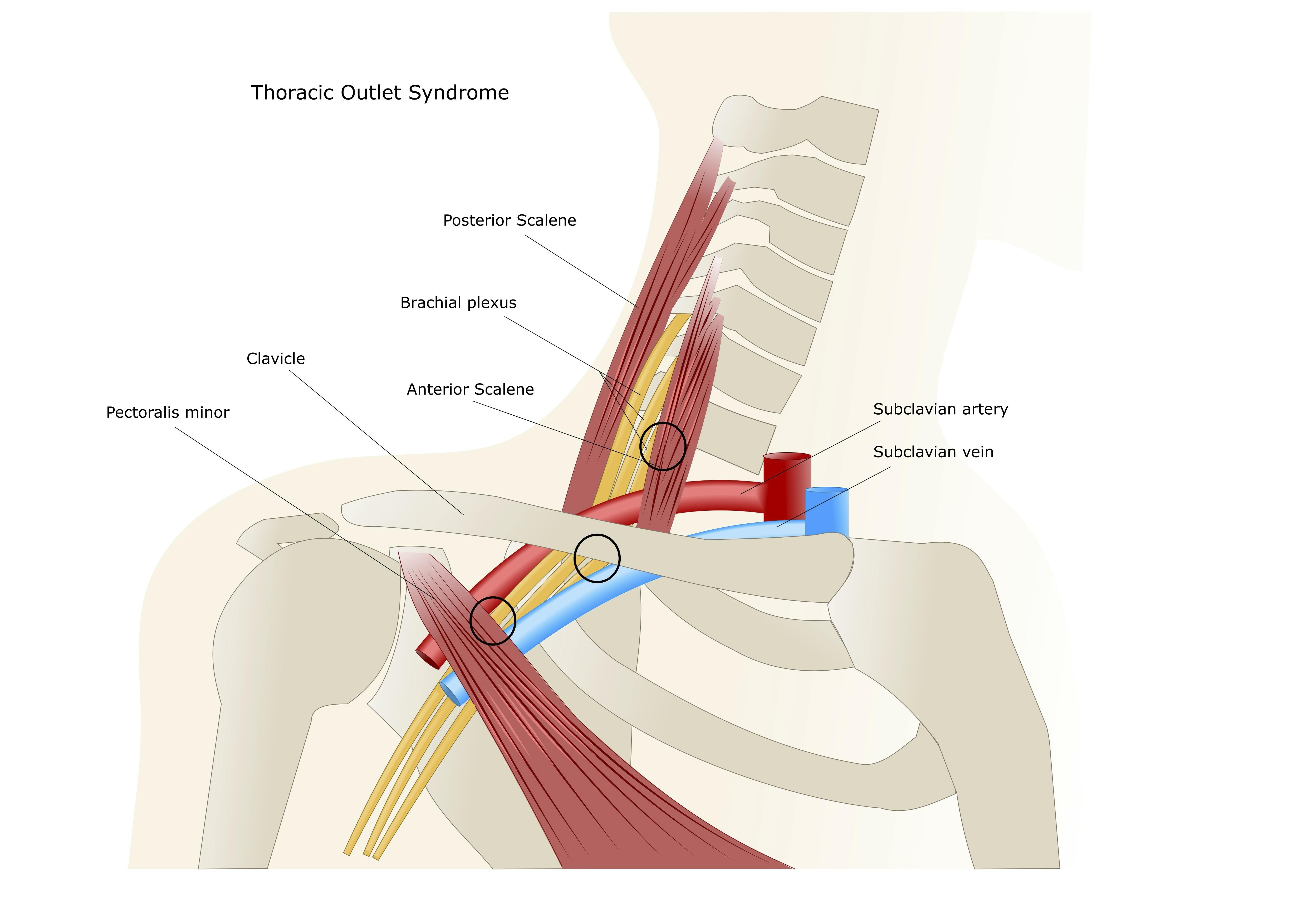Thoracic outlet syndrome (TOS) involves compression of the major nerves and blood vessels between your neck and shoulder. More than 90% of cases involve compression and irritation of the nerves as they pass through the thoracic outlet. It is less common for the blood vessels to be involved.
Common symptoms of thoracic outlet syndrome include pain in the neck, upper back, shoulder, arm, or hand. It is common to experience numbness, tingling, and weakness in your arm, hand, and fingers. Symptoms are aggravated with overhead positions. Also, repetitive tasks like prolonged typing exacerbate symptoms of TOS.
Anatomy of the Thoracic Outlet

There are 3 components to the thoracic outlet extending from your neck to the front of your shoulder.
- The 1st component is the interscalene triangle. Nerves exit the neck and pass between the two scalene muscles. Abnormalities of these muscles contribute to compression or irritation of the nerves.
- The 2nd component of the thoracic outlet is called the costoclavicular space. This is the area between your collarbone and first rib. Abnormalities of the first rib or an extra rib sometimes called a “cervical rib” lead to irritation of the nerves or blood vessels.
- The 3rd component of the thoracic outlet is the area between your pectoralis minor muscle and rib cage.
Treatment for Thoracic Outlet Syndrome
Treatment for TOS begins with rest from any aggravating activity like overhead sports (baseball pitching) or repetitive tasks such as keyboarding. Referral to a physical therapist is the next step. Physical therapy for thoracic outlet syndrome targets the 3 primary compression sites.
Manual therapy techniques and stretching exercises target the scalene muscles, first rib, and pectoral muscles. Nerve gliding exercises are prescribed to improve the health of irritated nerves. Postural correction exercises are also an important component. A slouched or flexed posture closes down the space of the thoracic outlet and increases irritation of the nerves and blood vessels.
Finally, pain-free strengthening exercises for the shoulder and upper back muscles are prescribed based on your needs and goals.
Scalene Muscle Stretch
Stretching your scalene muscles alleviates irritation of the nerves and blood vessels within the interscalene triangle. Sit with a strap or belt draped over your affected shoulder. Pull down on the strap towards your opposite hip. Side-bend the neck away from the affected side and slightly turn towards the affected side. Finally, perform a gentle chin tuck to increase the stretch in the side of the neck.
Hold this position for 30 seconds. If you experience symptoms during the stretch, start with shorter hold times and work up to 30 seconds.
First Rib Self-Mobilization
Improving the mobility and position of your first rib alleviates irritation of the nerves and blood vessels just below it. Sit with a strap or belt draped over your affected shoulder. Pull down on the strap towards your opposite hip. Side-bend your neck toward the affected side. Look down to the armpit. This position relaxes your scalene muscles so the forces are directed to the rib.
While holding pressure with the strap, perform 10 slow and deep breaths to mobilize the rib.
Pec Minor Stretch
Improving pectoralis minor length and mobility alleviates irritation of the nerves under this muscle. Begin lying over a foam roll under your hips and spine. With your elbow bent allow your arms to fall towards the floor. Fully exhale and relax in this position for 30 seconds. Your spine needs to maintain contact with the foam roll.
If you experience symptoms during the stretch, start with shorter hold times and work up to 30 seconds.
Trapezius Muscle Strengthening
To strengthen your lower trapezius muscle lie face down with one arm over the table or bench. Keep your neck in a relaxed neutral position resting on your other forearm. With your thumb up, arm straight, elbow slightly bent, lift toward the ceiling at a 45-degree angle from your head (the 10:00 and 2:00 positions of a clock). This position is aligned with the muscle fibers of the lower trapezius.
Be careful to avoid shrugging your entire shoulder as you raise your arm. Instead, tilt your shoulder blade backward as you raise your arm. Pause at the top of the movement before returning to the start position.
Train your middle trapezius similarly. To target your middle trapezius perform the movement with the arm straight out to the side. This corresponds to the 9:00 and 3:00 positions of a clock. Strengthening both the middle and lower trapezius will better orient your shoulder blade and decrease nerve irritation.
Do 2 to 3 of 10 to 15 repetitions for trapezius strengthening exercises. Use light weights (1 to 3 pounds) to maintain perfect form.
Get More Help for Thoracic Outlet Syndrome
Thoracic outlet syndrome can be debilitating and negatively impact your quality of life. Not everyone with TOS has to suffer. These 5 exercises are only a small sample of treatments that will help. Also, manual therapy will help speed up your recovery.
Meet with your physical therapist and start on the road to recovery. Your physical therapist will continually assess your injury and progress your exercise program based on your goals. The objective is to decrease pain and give you your quality of life back as quickly as possible.
Contact us today if you are experiencing symptoms suggestive of TOS or if you have questions about which treatments are right for you.


